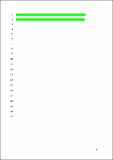Por favor, use este identificador para citar o enlazar a este item:
http://hdl.handle.net/10261/205376COMPARTIR / EXPORTAR:
 SHARE SHARE
 CORE
BASE CORE
BASE
|
|
| Visualizar otros formatos: MARC | Dublin Core | RDF | ORE | MODS | METS | DIDL | DATACITE | |

| Título: | Inheritance of winemaking stress factors tolerance in Saccharomyces uvarum/S. eubayanus × S. cerevisiae artificial hybrids |
Autor: | Origone, Andrea C.; González Flores, Melisa; Rodríguez, M. Eugenia; Querol, Amparo CSIC ORCID; Lopes, Christian A. | Palabras clave: | Cryotolerance Wine Sulphite Ethanol Climate change |
Fecha de publicación: | 3-ene-2020 | Editor: | Elsevier | Citación: | International Journal of Food Microbiology 320:108500 (2020) | Resumen: | Stress has been defined as any environmental factor that impairs the growth of a living organism. High concentrations of ethanol, sugars and SO2 as well as temperature variations occurring during winemaking processes are some recognized stress factors that yeasts must overcome in order to avoid stuck or sluggish fermentations. At least two of these factors -sugar and ethanol concentrations- are strongly influenced by the global warming, which become them a worry for the future years in the winemaking industry. One of the most interesting strategies to face this complex situation is the generation of hybrids possessing, in a single yeast strain, a broader range of stress factors tolerance than their parents. In the present study, we evaluated four artificial hybrids generated with S. cerevisiae, S. uvarum and S. eubayanus using a non-GMO-generating method, in their tolerance to a set of winemaking stress factors. Their capacity to overcome specific artificial winemaking situations associated with global warming was also analyzed. All four hybrids were able to grow in a wider temperature range (8‐37 °C) than their parents. Hybrids showed intermediate tolerance to higher ethanol, sugar and sulphite concentrations than their parents. Additionally, the hybrids showed an excellent fermentative behaviour in musts containing high fructose concentrations at low temperature as well as under a condition mimicking a stuck fermentation. | Versión del editor: | https://doi.org/10.1016/j.ijfoodmicro.2019.108500 | URI: | http://hdl.handle.net/10261/205376 | DOI: | 10.1016/j.ijfoodmicro.2019.108500 | ISSN: | 0168-1605 |
| Aparece en las colecciones: | (IATA) Artículos |
Ficheros en este ítem:
| Fichero | Descripción | Tamaño | Formato | |
|---|---|---|---|---|
| IJFM2020-Origone.pdf | Artículo principal + material suplementario | 1,87 MB | Adobe PDF |  Visualizar/Abrir |
CORE Recommender
SCOPUSTM
Citations
8
checked on 11-abr-2024
WEB OF SCIENCETM
Citations
4
checked on 28-feb-2024
Page view(s)
155
checked on 19-abr-2024
Download(s)
222
checked on 19-abr-2024
Google ScholarTM
Check
Altmetric
Altmetric
Este item está licenciado bajo una Licencia Creative Commons



